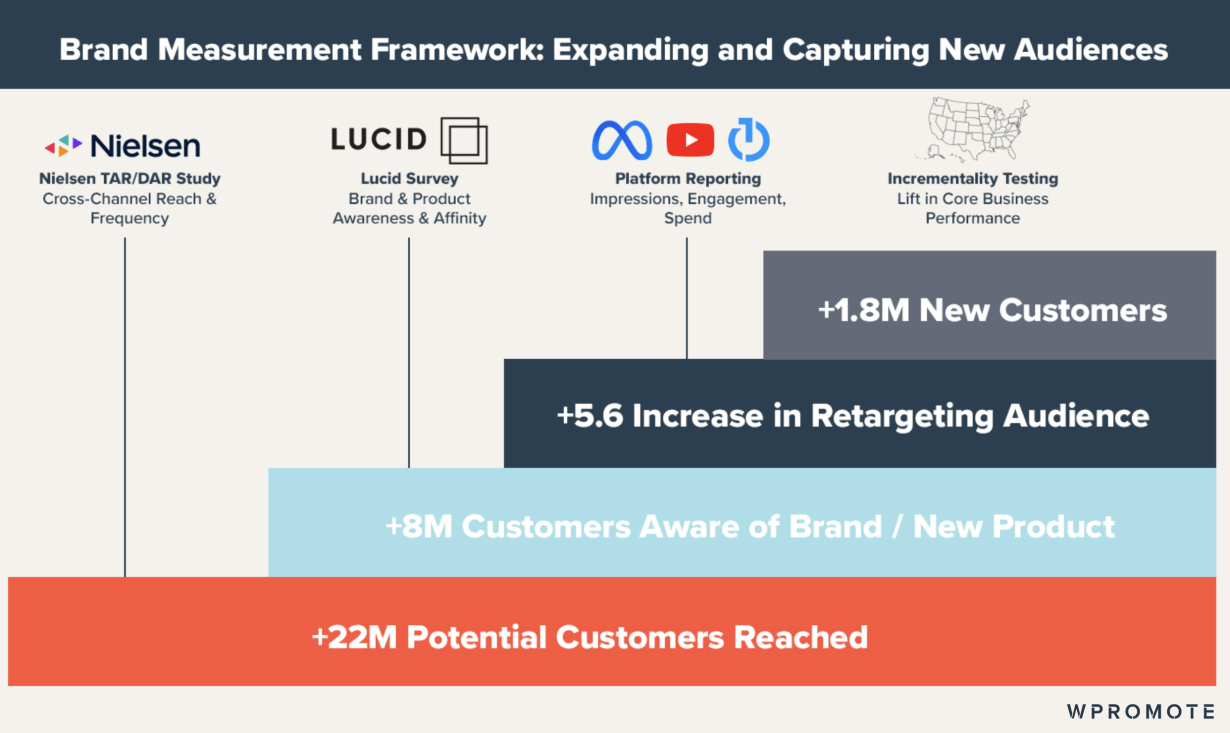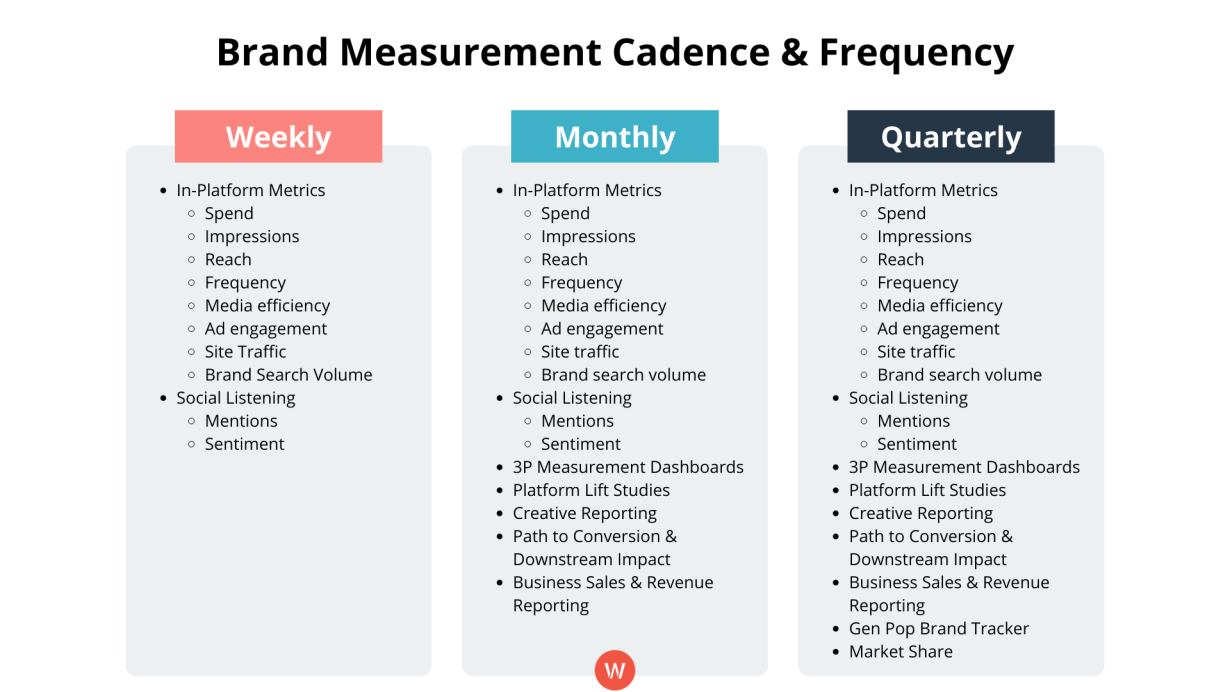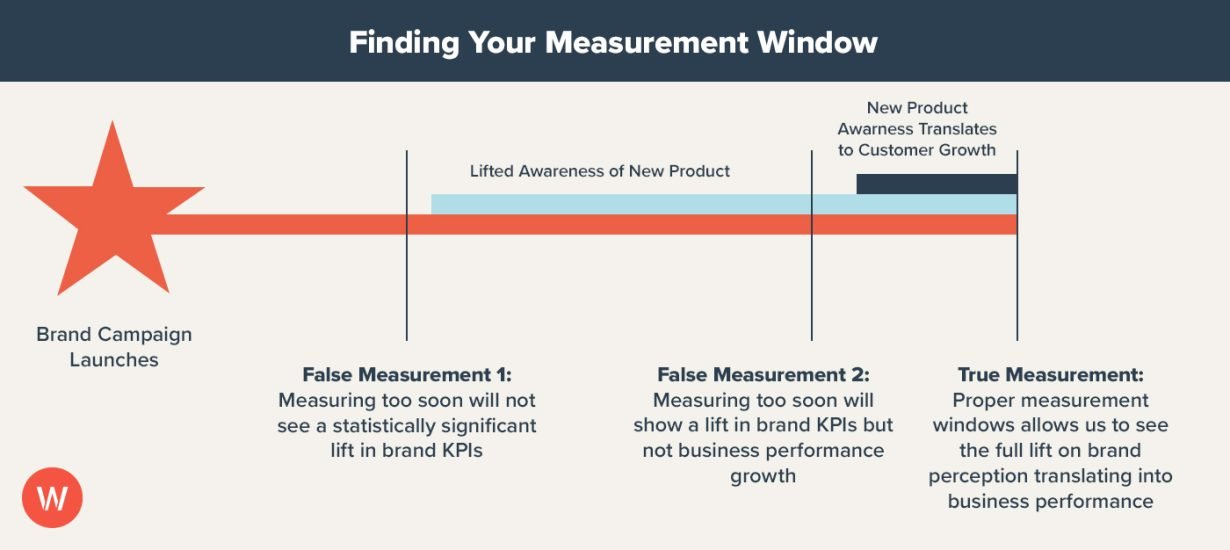Brand marketing has always suffered from a big weakness: the lack of clarity about impact on the business. In short, the upper funnel has a measurement problem. Or, as we like to think about it, a measurement challenge.
That’s only getting more acute in a challenging economic landscape, as brands pivot toward a focus on profitability and prioritizing budget accountability. That can make it easy to discount brand marketing: if your brand has set up precise ROAS targets, the upper funnel can be the first thing to go.
Without a defensible brand marketing measurement strategy in place, budgets will be slashed.
There is a better way.
You need to be able to know what’s working and what’s not on the brand side, and that doesn’t mean applying the same KPIs you use on the performance side to your brand initiatives (or shutting it off when it can’t live up to those expectations).
So how can you set up a measurement framework that holds brand dollars accountable and actually works with the metrics that make sense for the upper funnel?
Performance-driven triggers: how to know if you’re underindexing brand marketing
Brand marketing is essential to achieving a variety of objectives, including acquiring new customers, generating product awareness, or changing brand perception. In an ideal world, it’s working together with your performance media to expand the upper funnel, driving more primed audiences into your conversion-ready campaigns.

There are triggers you should recognize on the performance media side that will actually let you know when you need to turn up the volume on the brand side and better prime your audiences before engaging them in direct response campaigns.
You need to look out for:
- A revenue gap between target and forecast: While there are strategies you can deploy to increase recurring revenue, there will likely be a need for a strategic effort to increase new customer acquisition, depending on the size of the delta.
- A declining percentage of new customers: If your ratio of new customers to total customers declines and then sustains at a lower rate, it could be an indicator of future sales trends.
- Decreased brand search volume: Brand search volume is one of the strongest signals of brand intent and changes can be a predictive indicator of business results.
- Low new product adoption: If new products are released and don’t achieve their sales targets while customers continue to purchase from the wider, existing product assortment, it can indicate a lack of awareness of new offerings from the brand.
- Less efficient performance campaigns: First, a caveat: there are a lot of levers you can pull to generate more optimal outcomes from paid media campaigns, including campaign structure, audience strategy, creative, and user experience factors. You also need to make sure your foundational data structure is built so you can identify the right signals to use for optimization. But even if your direct response campaigns are operating at the very tippy-top of performance marketing excellence, efficiency can be impacted by a lack of full-funnel strategy. Then you need to invest in expanding marketplace awareness or increasing awareness in your ideal audience cohort to fuel downstream conversions captured by performance campaigns.
All of these signals can help you build the case for brand marketing investment, but identifying potential problems to solve isn’t enough. You also need to be able to communicate the actual value of your efforts to build trust with decision-makers and get full buy-in for the long term.
Accountability: aligning brand strategy with business objectives
Performance marketers are often wary of brand initiatives for a couple reasons, but the biggest might be a misconception: that brand marketing can’t be held to the high standard of accountability that direct response campaigns are.
That’s why any case for brand investment needs to start with an accountability framework that is rooted in specific objectives and includes opportunity and challenge indicators as well as clear goals.
The process is fairly simple:
- Define your objectives and goals, then what KPIs you will use to quantify them
- Scope and set up the data requirements/measurement tools you’ll need to get those metrics
- Incorporate incrementality testing
- Demonstrate how campaign KPIs map to business performance and financial impact
Let’s take a closer look at step one. Your objectives are the answer to the big question: “what are we trying to achieve?” Then you need to identify the specific metrics that will help you evaluate how effectively your brand campaigns are performing against those objectives.

Your goal should be to draw a clear line between your brand marketing plan and your overall business objectives, then show how you plan to hold those campaigns accountable. Once you’ve got all of those definitions in place, you’re ready to consider how you’ll actually measure the impact on the business itself.
The secret sauce: building a strong brand measurement framework
Understanding which KPIs correspond with your objectives is a start, but you need a measurement framework in place to get the full picture of performance against business goals.
If your ultimate objective is to acquire new customers, for example, the first step in your strategy is to identify the target audience that closely aligns with your brand or product. Your media mix will focus on different ways to reach that audience, and your measurement framework needs to reveal how effectively your advertising efforts have raised awareness about your brand or product with those potential customers.
A full brand measurement solution will incorporate different methodologies that generate insights into how effectively your media investment is driving incremental increases in new customers. You’ll need a few things in place to make it happen.
Make sure your measurement framework is set up to facilitate cross-channel measurement, which typically requires tools like Google Analytics and data clean rooms. By incorporating platform analytics like engagement and spend, you can start to see how you are driving acquisition. But that’s not sufficient: you also need to deploy incrementality testing to get the full picture of how many new customers you’re actually generating through marketing activations.

One of the biggest challenges for performance-minded marketers breaking into brand marketing is setting appropriate expectations with both execs and team about what will be evaluated and when. You need to manage the expectations of decision-makers if they’re looking for immediate impact. Set up a weekly, monthly, and quarterly measurement frequency to highlight the leading vs. lagging indicators based on the amount of data required to get an actionable read.

Effective brand measurement also requires an appropriate window to properly observe a true lift in brand KPIs like awareness of a new product and the subsequent lift on key business outcomes like sales of the new product or new customer acquisition.

To build your case successfully, you’ll likely need to expend some effort on internal education. Stakeholders must understand both the challenge at hand and how brand initiatives will solve for it, as well as how you plan to measure the impact of brand marketing initiatives and the internal operational processes that need to be put in place.
This is especially important when the economy is in flux; many brands react to uncertainty by holding back spend and even eliminating brand marketing budgets to refocus on short-term performance. But that approach can be extremely detrimental to the business in the long term.
By approaching brand marketing with a clear measurement strategy in place and a commitment to ongoing education and accountability, you’ll be better positioned to defend or even grow your budgets and build a strong brand that makes a tangible impact on your business.








Responses